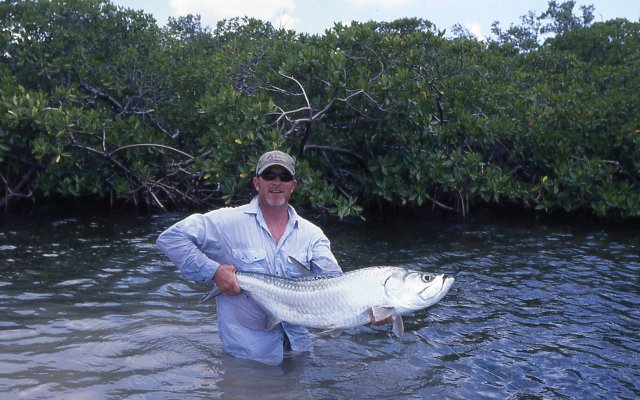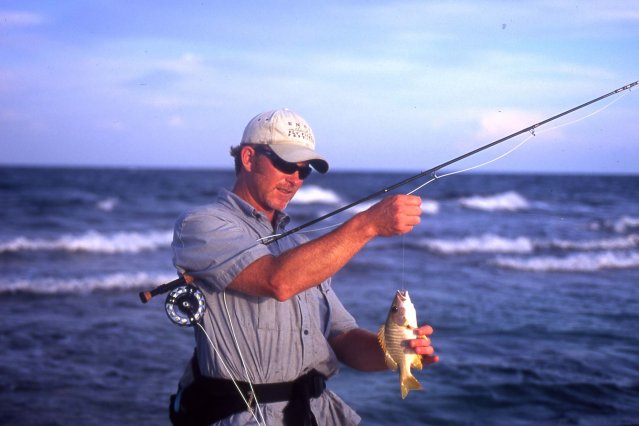There’s nothing wrong with guided trips. In many cases, a guide is absolutely necessary, a man or woman to navigate a boat, to tie the proper knots and leaders, a person who can point to the proper three-foot square surface area of water and say, “Cast there, hook that fish, mon.” In downtimes, a good guide can keep the day alive with stories from their respective homelands.
On the other hand, a guide can dominate the angling experience making a client seem insufficient, dependant. An overbearing guide can take the sweet elements of fly fishing—intuition, discovery, challenge and reward—and flush them right into the Gulf Stream.
That wasn’t the case when I visited Turneffe Flats Lodge in Belize. My pal, Dan, and I were fortunate enough to draw Pops Cabral, a long-time Turneffe Flats guide with lots of outlandish stories and a nose for tarpon, permit and bonefish. During a weeklong stay at Turneffe Flats, Cabral led us to numerous bonefish and four very impressive tarpon, including a couple 125-pounders. And we lost a fish that may have gone, according to Cabral, “one-eighty, maybe two-hundred.”
While the “Big Three” dominated our mindset and angling hours in Belize, Dan and I stole away a few precious hours and waded out to the barrier reef to test the water on our own, unguided, to see what we might see, to discover something about Belize and Turneffe in particular, that wasn’t served to us on a plate. It was an opportunity to say, “It doesn’t matter if we catch a fish or not. We’re just going for the hell of it.” I’d been so wound up on big tarpon and shots at permit that I felt as if my blood pressure was about to blow. Walking the reef would offer some relief.
I don’t know how far we stumbled along, maybe a mile, maybe less, maybe a bit more, but we found a plethora of exotic species there for the taking. Blue runners, mini-groupers, grunts, parrotfish, nurse sharks, triggerfish, boxfish, squirrelfish, schoolmasters … too many to identify, let alone catch. But we caught as many as we could while shouting back-and-forth, “Hey come here. Check this one out. How cool is this?”
I remember one instance, when a large shark pushed through one of the widest reef-cuts, riding the waves with no urge to be anywhere fast. I was carrying a nine-weight Sage XP—a strong rod for sure—but not the type you strike six-foot nurse sharks with. But I wanted to see what would happen, possibility of a broken rod or not. I ran across the coral, stripping line as I leaped from one head to the other. Finally, with the shark just leaving the cut, moving into the ocean swell, I launched a cast that landed just ahead of its snout. I gave three quick strips and just as quickly, I watched that shark swim away as if nothing in the world mattered.
Dan and I waded across that cut, water reaching our chests, rods and cameras held high overhead. After passing the cut and taking a deep breath (good to be alive, isn’t it we agreed) Dan and I sat on the reef, popped the tops off a couple Belikin’s and laughed at the possibilities. It wasn’t like this was the most glamorous fishing in the world and it couldn’t replace the thrill of a tarpon take and that first jump or casting to a cruising permit, but at the same time this wasn’t the brow furrowing, heart-bursting pressure-cooker that we’d engaged for five days while chasing tarpon, permit and bonefish. This was a relaxed experience and, under 85 degree sun, with a couple of beers cracked and miles of unexplored reef for the taking, it seemed to be some of the best fishing I’d ever experienced.
As I was saying, “Now this is some cool fishing,” Dan interrupted with, “Damn man, look at that fish in the waves! It’s a permit or a big jack.” Dan leaped to his feet, stripped line and threw ahead of that fish. Nothing. Not on the first cast, the next or the following. But, on the fourth cast, the fish took, ran 30 yards without slowing below 20 and then bit through the line. I cast back into the calm water and hooked another schoolmaster, a fish with a spiny dorsal fin, big, black eyes, vertical yellow lines down its sides, yellow-tipped fins, and a body built out of a football mold. Typically, those fish measured 10 inches. Despite their size they bent a nine-weight with intent.
Of all the reef fish we saw and caught, I guess I liked the schoolmasters best. They were sizeable little fish, eager to snap up a shrimp imitation. They demonstrated sincere talent as a gamefish, a fish that most people wouldn’t bother to chase, caught up as most of us are for the glam species. That’s at once a shame and a joy, because around the globe—near your home or at faraway in places like the atolls of Belize—there are overlooked species waiting to be tested, opportunities for anglers to leave the guides and the fly-fishing rat race behind—for a while at least—and enjoy days of solitude, laughter, contentment, and discovery. Which, is basically what it’s all about, right?


